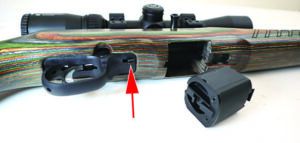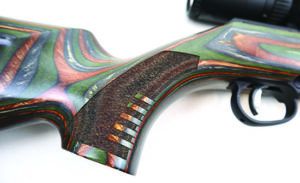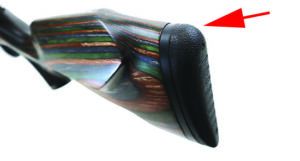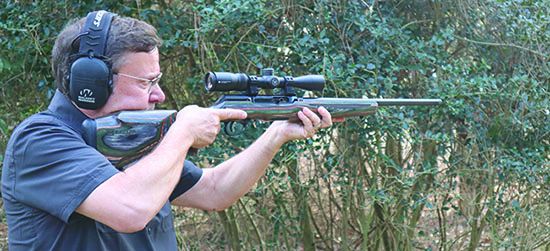Semi-automatic 22 LR rifles are a mainstay with shooters and hunters. These rimfire rifles are fun to shoot and offer fast follow-up shots when plinking, small-game hunting, informal precision shooting, or pinging steel plates. Plus, ammo is inexpensive. However, not all 22 rimfire rifles can do all things well. That’s why there are specialized models. For this match up, we wanted to look at 22 LR semi-auto rifles that could easily be used for hunting as well as dabble in fast shooting competition, or maybe punch tiny groups at the local range for bragging rights among our pals. We didn’t want to feel undergunned or overgunned in the scenarios mentioned above, but we wanted a moderately priced do-all type of rifle/scope combo. Must-haves for these rifle/scope combos were: accuracy, a trigger that would not force us to cuss, comfortable stock, and mounting an optic needed to be easy and simple. If the rifle were further customizable, it earned bonus points. The three rifles in this review are the Bergara BXR, Ruger 10/22 Target, and Savage A22.
How We Tested
We mounted scopes on the rifles and zeroed in at 50 yards. The Savage came with a two-piece Weaver base mounted on the receiver, and it was simple and easy to mount the optic. Mounting a scope on the Bergara was even easier because it came with a Picatinny rail screwed on to the receiver. The Ruger came with a base. Removing the base plug screws were a pain because the finish was heavy and clogged up the tiny screwhead slots. After that, mounting the rail and the scope was a simple task.
A few issues back we tested a Vortex Crossfire II 2-7x32mm rimfire SFP scope ($149; OpticsPlanet.com) with a simple V-Plex MOA reticle similar to a Duplex reticle. We become partial to this scope. We used Vortex Pro Series 1-inch medium-height rings ($79; MidwayUSA.com) to mount the scope to the Savage and the Bergara. On the Ruger, we placed a Hawke Vantage IR 3-9x40mm scope ($159; OpticsPlanet.com) with a Rimfire 22 HV reticle. Because the Ruger came with a Weaver-style scope base adapter that also allows use of claw-style rings, we used NCStar 3⁄8-inch dovetail 1-inch rings ($13; Amazon.com) to attach the scope to the base.

The Ruger is a straight-comb-stock rifle, like an AR-15, and the Hawke Vantage setup offered the correct height for proper eye alignment and shooting comfort. The reticle is a BDC (Bullet Drop Compensating) style reticle calibrated for 22 LR ammunition loaded with 36- to 40-grain bullets with a muzzle velocity range of 1235 to 1260 fps. You need to dial the optic to 9x to use the BDC feature, and it worked well out to 100 yards. There are no hash marks on the horizontal strata to compensate for wind, though there is 2.1-minutes-of-angle (MOA) space between the vertical strata to the thicker duplex horizontal strata, so this can be used to determine a hold. The BDC hash marks are labeled out to 200 yards in 25-yard increments. The reticle also illuminates red or green with five levels of brightness intensity.
Clarity was good for both scopes at this price point. Both scopes have screw-on turret caps, and we would be sure they are screwed on if we were in the field and it started to rain. In our opinion, the BDC reticle in the Hawke is more practical than the V-Plex reticle in the Vortex if you plan on long-range shooting. From plinking distance out to 100 yards, these scopes work well and won’t break the bank.
We purposefully didn’t bore-sight the rifles because ammo was cheap and we wanted to test the turrets and adjustment accuracy on the scopes. Zeroing all the rifles was an easy task. The clicks were solid and easily rotated with our fingers. The direction was clearly marked on both scopes. With the rifles zeroed, we used a bench and rest to gather accuracy data. We also fired the rifles offhand to get a feel for how they would be in the field. Ammunition was inexpensive CCI Blazer with a 38-grain LRN bullet, Federal Auto Match with a 40-grain solid lead bullet, and hot CCI Stangers using 32-grain copper-plated hollow points. Here’s how everything performed at the range:
Savage A22 BNS-SR 47249 22 LR
$440
Gun Tests grade: A-
The A22 had good accuracy and good looks. The trigger had some creep, and loading the magazine took practice. This is a good choice as an adult-size rimfire rifle with traditional styling.

| Action Type | Semi-automatic |
| Overall Length | 37.0 in. |
| Barrel Length | 18.0 in. |
| Twist Rate | 1:16 in. |
| Muzzle Device | None, threaded |
| Sights | Optics ready, Weaver 2-piece base |
| Weight Unloaded | 6.6 lbs. |
| Weight Loaded | 6.7 lbs. |
| Capacity | 10 |
| Stock | Wood laminate |
| Stock Length of Pull | 13.6 in. |
| Buttplate | Rubber |
| Action Finish | Blued |
| Barrel Finish | Blued |
| Magazine Type | Detachable, plastic, 10-rnd. box |
| Trigger Pull Weight | 5.5 lbs. |
| Safety | Manual thumb |
| Accuracy Guarantee | None stated |
| Warranty | 1 year |
| Telephone | (800) 370 0708 |
| Website | SavageArms.com |
| Made In | U.S. |
The A22 is a descendant of the Savage A17 in 17 HMR and the A22 in 22 WMR, both of which use a delayed-blowback action. The Savage A22 in 22 LR uses a simple blowback action that ran without fail during the entire test. There is a polymer dust cover on the back, similar to an AK-47 rifle’s, that allows access to the recoil assembly. The barreled receiver must be removed from the stock to clean the rifle, which is tedious but very simple. A 5⁄32 hex wrench is required, and a small punch helps with the pins.
The rifle came with Weaver two-piece bases on which the Vortex scope was mounted. The A22 looks handsome with what Savage calls a Timber hardwood laminate stock. This is a very comfortable stock to shoot with a modern take on the classic Monte Carlo-style cheek riser. All the gripping areas had plenty of stippled texture and serrations. Slings studs are installed. The buttpad was rubber with nicely rounded edges for no-snag shouldering. The fore end is thick in the gripping area and slims down toward the receiver. The rifle feels substantial in hand. It is heavy at more than 7 pounds loaded and feels like a centerfire rifle. This is definitely an adult-size rifle. The metal work wore a blued finish on the receiver and the 18-inch threaded-muzzle barrel.

Controls consisted of a simple crossbolt safety that blocks the trigger. The large button is located in the front of the trigger guard and works easily for a right-handed shooter. The charging lever is rounded and comfortably rolls with your fingers when racking it back to load the rifle. A small button on the underside of the rifle just forward of the trigger guard is the bolt-hold-open button. The bolt does not lock open when the last shot is fired.
The magazine is a rotary-style device made of polymer and metal and holds 10 rounds. The back is metal and the front is polymer. It fits easily into the rifle and locks solidly into place.
It took a minute or two to figure out how to load the magazine because it looks like a Ruger 10/22 magazine, but is loaded differently. Inside the magazine is a rotary dial with a slot for each cartridge. As you insert the cartridge, you need to push it down and to the side so the cartridge slips into its own slot. We mastered it quickly, but there was a learning curve.

The AccuTrigger trigger was set at 5.5 pounds, which we thought was too much, but we rolled with it. You can adjust the trigger if you so desire. There was some creep to it, but that did not stop us from wringing out decent groups. The smallest five-shot group fired was with Federal Auto Match ammo with a 40-grain solid-lead bullet. It measured 0.49 inches. On average across all ammo, the average group size was 0.77 inches.
The Savage was the least accurate rifle in the match up, but it still was not bad. Shooting the A22 from the bench was fairly comfortable. The stock has some bench-shooting features like a fairly flat toe for a toe bag. The fore end is slightly rounded, so it does not lie flat on a rest. Not a disqualifier by any means. There were no issues with the rifle. It spit out empty cases as fast as you can press the trigger.
Our Team Said: The A22 is accurate, easy to operate, and adult sized. We’d decrease the trigger-pull weight if we owned this rifle. The Savage offers a lot of performance for less money and feels substantial in hand compared to less expensive polymer-stock rimfire rifles. We like that a muzzle device can be added. Choose this rifle if you want a traditional, adult-sized 22 LR semi-auto and don’t care about aftermarket parts.
| 22 LR RANGE DATA | |||
| CCI Blazer 38-grain LRN | Bergara BXR Steel | Ruger 10/22 Target | Savage A22 BNS-SR |
| Average Velocity | 1239 fps | 1240 fps | 1135 fps |
| Muzzle Energy | 129 ft.-lbs. | 130 ft.-lbs. | 109 ft.-lbs. |
| Smallest Group | 0.45 in. | 0.55 in. | 0.76 in. |
| Average Group | 0.48 in. | 0.70 in. | 0.81 in. |
| Federal Auto Match 40-grain Solid | Bergara BXR Steel | Ruger 10/22 Target | Savage A22 BNS-SR |
| Average Velocity | 1142 fps | 1143 fps | 1139 fps |
| Muzzle Energy | 116 ft.-lbs. | 116 ft.-lbs. | 115 ft.-lbs. |
| Smallest Group | 0.59 in. | 0.49 in. | 0.49 in. |
| Average Group | 0.63 in. | 0.60 in. | 0.57 in. |
| CCI Stangers 32-grain Copper Plated HP | Bergara BXR Steel | Ruger 10/22 Target | Savage A22 BNS-SR |
| Average Velocity | 1515 fps | 1523 fps | 1540 fps |
| Muzzle Energy | 163 ft.-lbs. | 165 ft.-lbs. | 169 ft.-lbs. |
| Smallest Group | 0.89 in. | 0.78 in. | 0.72 in. |
| Average Group | 0.98 in. | 0.84 in. | 0.95 in. |
How we tested: To collect accuracy data, we fired five-shot groups at 50 yards from a bench using a rest. We used a Garmin Zero C1 Pro chronograph to record velocities.
Written and photographed by Robert Sadowski, using evaluations from Gun Tests Team members. GT





























